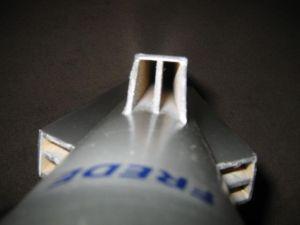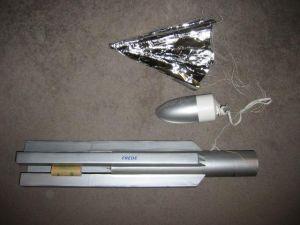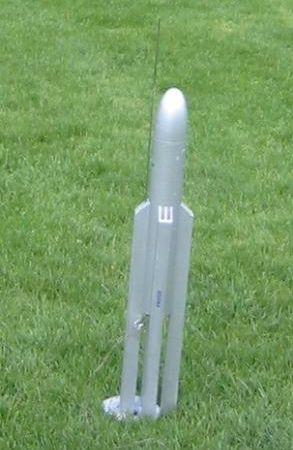| Construction Rating: | starstarstarstar_borderstar_border |
| Flight Rating: | starstar_borderstar_borderstar_borderstar_border |
| Overall Rating: | starstarstar_borderstar_borderstar_border |
| Manufacturer: | Rocket Pad |

Brief:
Frede Kit #1005 is a 1/300 scale model of the 1929 sci-fi movie rocket ship
featured in Fritz Lang's film, Frau im Mond.
Construction:
Included in the kit:
- balsa and basswood for fins
- light plywood centering rings
- engine hook, motor mount and motor block
- Kevlar® and shock cord
- BT-80 body tube and Fat Boy type plastic nose cone
- mylar parachute
- clay to adjust nose weight
- spacer for D motors
- launch lug
- waterslide decals
Instructions were pretty straightforward and included plenty of illustrations and text, but they were somewhat awkward since the instructions were on many separate sheets of paper. I had to go through the pages a number of times to get everything in the right order before I began building.
First, I constructed the motor mount. I found the plywood to be great quality. I liked the fact that there was a notch to pass the Kevlar® through. One thing odd about the centering ring though was that it featured extra laser cut around the hole in the middle so that it could be converted to a 29mm motor mount. I assume these centering rings can be interchanged for different Rocket Pad kits. I just don't think that the wood around the hole is very solid, and I determined later it did turn out to be a structural weakness in the design.
 The motor mount
when complete fits easily into the body tube. Next, I used the fin marking
guide and made the appropriate marks on the body tube. I cut the balsa
according to directions. My original instructions said to cut four 18"
strips of balsa to a length of 8 3/4" long. Unfortunately, this left me
short on balsa for future steps. I should only have cut 2 strips, not 4. An
email to Rocket Pad corrected the problem. They immediately sent me fresh balsa
to replace the missing strips plus a set of updated instructions.
The motor mount
when complete fits easily into the body tube. Next, I used the fin marking
guide and made the appropriate marks on the body tube. I cut the balsa
according to directions. My original instructions said to cut four 18"
strips of balsa to a length of 8 3/4" long. Unfortunately, this left me
short on balsa for future steps. I should only have cut 2 strips, not 4. An
email to Rocket Pad corrected the problem. They immediately sent me fresh balsa
to replace the missing strips plus a set of updated instructions.
There is a template for making the fins. First, after all the wood is cut to the correct size and shape, I had to construct a kind of "L" and then add another piece on the other side, adding the fin strip down the middle. I added glue fillets as best as I could. I then sanded the fin structures on the body tube to give them a rounded edge so that they would seat better. With these fins, you need to glue 3 fins in the fin structure to the body tube, making sure each fin is in contact with the body tube.
 I added more
fillets. Next, I cut the basswood to fit the back of the fins that extend
beyond the body tube and made sure they fit the rocket flush at the bottom. I
had to do a little more sanding of the feet so that the rocket would stand up
straight. This was for me probably the most time consuming part of the build. I
placed the launch lug inside the fin structure so that it would not be visible
outside the rocket. Hiding the launch lugs is probably the nicest idea of the
kit.
I added more
fillets. Next, I cut the basswood to fit the back of the fins that extend
beyond the body tube and made sure they fit the rocket flush at the bottom. I
had to do a little more sanding of the feet so that the rocket would stand up
straight. This was for me probably the most time consuming part of the build. I
placed the launch lug inside the fin structure so that it would not be visible
outside the rocket. Hiding the launch lugs is probably the nicest idea of the
kit.
Last, I added the necessary nose weight and made the mylar parachute
PROs: Good customer service in getting me replacement parts
CONs: The centering rings appear weak. There are many unattached pages of instructions making the build a bit confusing at first. Also, a bunch of spelling/typo errors annoyed me a little (such as "lunch lug" and the incorrect instructions to cut the balsa).

Finishing:
I decided instead of filling in all the balsa to use large white Avery labels
to cover all the balsa. I added extra fillets and primed the rocket with gray
primer. Next, I gave it two light coats of a silver/aluminum paint.
There were waterslide decals that came with the rocket. They weren't very spectacular, just a few rectangles to represent windows, and a couple that said "FREDE" to place around the rocket. I then coated the decals with some MicroSol solution and coated the entire rocket with Future Floor Finish. It didn't look too bad after finishing. According to the instructions, the rocket is supposed to weight just shy of 8 ounces. Mine came in around 9 ounces.
Construction Rating: 3 out of 5
Flight:
I flew the rocket 3 times, twice on D12-3s and once on a F21-6. I prepped the
rocket and used dog barf for wadding as the body tube is quite large.
The first time I flew the rocket, I made the mistake of using a standard length launch rod. The D12 lifted the bird, but it became neutrally stable pretty quickly, doing a few somersaults, then landing nose first in the ground before the parachute ejected. Surprisingly, only one fin had a minor fracture and the damage was more cosmetic than anything else.
 I decided to wait
until I could launch with my club to go for flights 2 and 3. On May 21, 2005, I
was flying with ASTRE (NAR #471) and had access to a large hay field and more
importantly, 3/16" launch rods that were quite long. The directions do say
to use only a 3/16" launch rod. I was certain that FREDE was going to fly
better on the longer rod. Well, she got off the ground again on the D12 and
gained more altitude than the previous flight but then began to do a little sky
writing. She did eject the parachute about 30 feet above the ground. Now I was
stumped. The rocket weight seemed fine and it passed the swing test but it just
didn't seem to hold up after motor burn out.
I decided to wait
until I could launch with my club to go for flights 2 and 3. On May 21, 2005, I
was flying with ASTRE (NAR #471) and had access to a large hay field and more
importantly, 3/16" launch rods that were quite long. The directions do say
to use only a 3/16" launch rod. I was certain that FREDE was going to fly
better on the longer rod. Well, she got off the ground again on the D12 and
gained more altitude than the previous flight but then began to do a little sky
writing. She did eject the parachute about 30 feet above the ground. Now I was
stumped. The rocket weight seemed fine and it passed the swing test but it just
didn't seem to hold up after motor burn out.
We discussed it as a club and decided that due to the narrow long fins and big, draggy body, the rocket would probably not fare better on an E9. I added extra nose weight and then proceeded with the third and final flight using an AT F21-6W. The motor chuffed a bit and finally let out a roar, lifting FREDE on her third expedition. We had more altitude than the D12, but once the rocket hit the coasting phase, it just could not continue in a straight line. I think the fins don't have enough effect on that size rocket. They should probably be a bit wider and a bit shorter. The rocket disappeared behind a bank and then we saw a huge puff of smoke. When I retrieved the rocket, it was clear it was still traveling at a good clip before it landed. The parachute did not have a chance this time. I assume ejection occurred after hitting the ground.
I was left with a rocket that had a huge tear in the body tube. Also, it seemed as if the centering rings were loose from the 2 crash landings. When I got home, I removed the nose cone for a scratch build, stored the parachute, pulled off the fins and body tube to retrieve the motor mount. Sure enough, the centering ring was cracking around the laser cuts surrounding the motor mount.
Recovery:
According to my experience, this rocket does not really fly. Every single
flight was a "heads up" launch. It needs to be reengineered. I am
certain that a Friede-type rocket can be kitted. Rocket Pad offers an unusual
attempt at the design but in the end, it is just too unpredictable in its
flight patterns.
Flight Rating: 1 out of 5
Summary:
I like the idea of a Friede kit. From a scale point of view, it is lacking in
some detail. First, the nose cone should have more of a point to it. Second,
the body tube and fin lengths are far too long. Also, the name is incorrect.
The rocket ship in Frau im Mond is named after the heroine, whose name
is "Friede", or "peace". For some reason, this rocket is
called FREDE, which when pronounced sounds more like 'fred-eh'.
Overall Rating: 2 out of 5
Other Reviews
- Rocket Pad Frede By Ron Shuber
Brief: This is a single stage skill level 3 kit. This kit is inspired by a rocket in a 1929 sci-fi movie. I built a Frede sometime back in early 2004 and lost it on a windy day so I got another one in September 2005. It uses an 18" mylar parachute. I enjoyed the first one, so that's why I got a second one. Construction: The kit comes with a 2.6" Estes type body tube. It ...
 |
 |